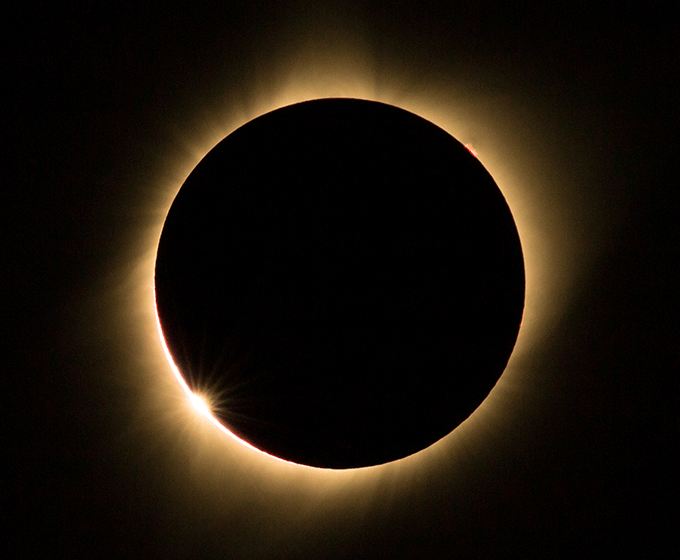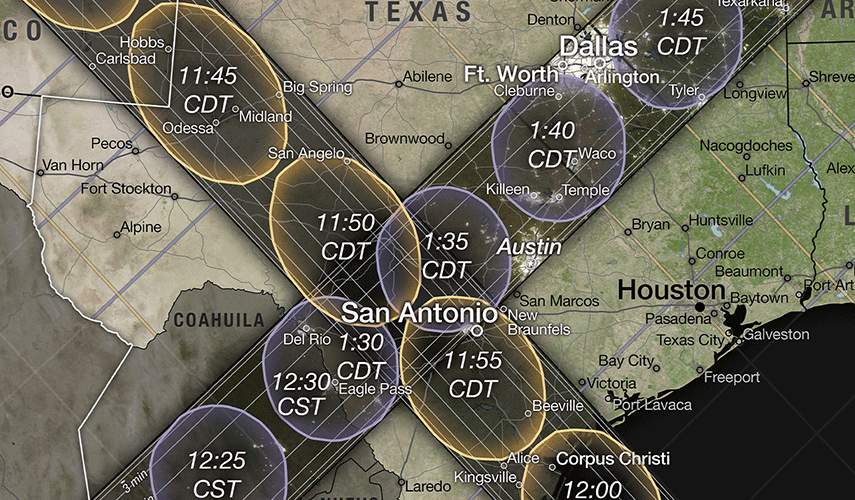
APRIL 7, 2023 — One year from Saturday, April 8, the moon will position itself between Earth and the Sun, creating an astronomical spectacle that Angela Speck says everyone must witness at least once in their lifetimes.
A total solar eclipse occurs when the moon passes directly between the Sun and Earth, casting a shadow on the planet. The occurrence can only be seen from a small portion of the Earth’s surface. During a total solar eclipse, the sky darkens and the temperature drops, creating an unforgettable experience.
“Most people don’t get to witness a total solar eclipse in their lifetime,” said Speck, professor and chair in the UTSA Department of Physics and Astronomy. “You have a year to plan where you’re going to be and it’s totally worth it getting into the path so you can witness this amazing spectacle.”
Eclipses provide scientists with a unique opportunity to study the sun's corona—the outermost layer of the sun's atmosphere—and learn more about how it interacts with the solar wind that affects Earth.
Even for those not involved in scientific research, witnessing a total solar eclipse can be a life-changing experience. It reminds us of the vastness and beauty of the universe we live in and helps us to put our own lives into perspective. It also provides a sense of connection to the natural world, something that can be easy to forget in our increasingly technology-driven lives.

This NASA map shows the paths of the upcoming annular solar eclipse on October 14, 2023 (in yellow), and the far more rare total solar eclipse on April 8, 2024 (in purple). Using observations from different NASA missions, this map shows where the Moon’s shadow will cross the U.S. during each eclipse. Photo courtesy of NASA/Scientific Visualization Studio/Michala Garrison; eclipse calculations by Ernie Wright and NASA Goddard Space Flight Center
“It’s the full-on experience of what you see, feel, hear, etc. It’s not like any other experience,” Speck said.
The path of totality—the narrow strip of land where the eclipse can be seen in its entirety—will pass through several major cities including San Antonio and Boerne, Texas. A partial eclipse will still be visible across much of North America for those not in the path of totality.
“The north and west parts of San Antonio will be in the path of totality. To watch a solar eclipse safely you need to either have special viewing equipment to protect your eyes or you use an indirect viewing technique like a pinhole camera. But once the moon completely blocks out the sun, you don’t need anything. It’s safe to look at,” Speck said.
The last total solar eclipse to grace the United States was on August 21, 2017. Next year’s eclipse is the last chance to catch a total solar eclipse stateside until 2044.
UTSA Today is produced by University Communications and Marketing, the official news source of The University of Texas at San Antonio. Send your feedback to news@utsa.edu. Keep up-to-date on UTSA news by visiting UTSA Today. Connect with UTSA online at Facebook, Twitter, Youtube and Instagram.
Move-in Day is an exciting time for incoming students. Students living in Alvarez Hall (2nd and 4th), and Chisholm Hall are moving in on August 19. The UTSA Housing and Residence Life (HRL) team looks forward to welcoming you all and helping you settle into your room.
Alvarez Hall and Chisholm HallMove-in Day is an exciting time for incoming students. Students living in Chaparral Village move in from August 20-21. The UTSA Housing and Residence Life (HRL) team looks forward to welcoming you all and helping you settle into your room.
Chaparral VillageMove-in Day is an exciting time for incoming students. Students living in Laurel Village move in on August 22. The UTSA Housing and Residence Life (HRL) team looks forward to welcoming you all and helping you settle into your room.
Laurel VillageThe College of Sciences welcomes our newest Roadrunners to UTSA at VIVA Science! This interactive event connects students with faculty, staff, student leaders, and peers while highlighting the opportunities available across the College.
Outdoor Learning Environment 2 (OLE), Flawn Building, Main CampusWe're excited to welcome the new class of UTSA College of Liberal and Fine Arts (COLFA) students to campus! Move In To COLFA is strongly recommended for new students in COLFA because it gives you the chance to learn about the Student Success Center, learn how to do college successfully and meet new friends.
Galleria (MH 2.01), McKinney Humanities Building, Main CampusBuild connections with your Alvarez College of Business peers and learn more about the Career Compass program! This opportunity will provide fun interactions, giveaways and a chance to meet your next friend!
Richard Liu Auditorium (BB 2.01.02,) Business Building, Main CampusCelebrate the end of summer and the start off a great fall semester with The Housing Block Party! This event will have live music, carnival-style treats, artists, games, and activities galore. Come and join us for a night of fun!
Multipurpose Room/Lawn, Guadalupe Hall, Main CampusThe University of Texas at San Antonio is dedicated to the advancement of knowledge through research and discovery, teaching and learning, community engagement and public service. As an institution of access and excellence, UTSA embraces multicultural traditions and serves as a center for intellectual and creative resources as well as a catalyst for socioeconomic development and the commercialization of intellectual property - for Texas, the nation and the world.
To be a premier public research university, providing access to educational excellence and preparing citizen leaders for the global environment.
We encourage an environment of dialogue and discovery, where integrity, excellence, respect, collaboration and innovation are fostered.